Square Tower, Portsmouth to Round Tower |
||||
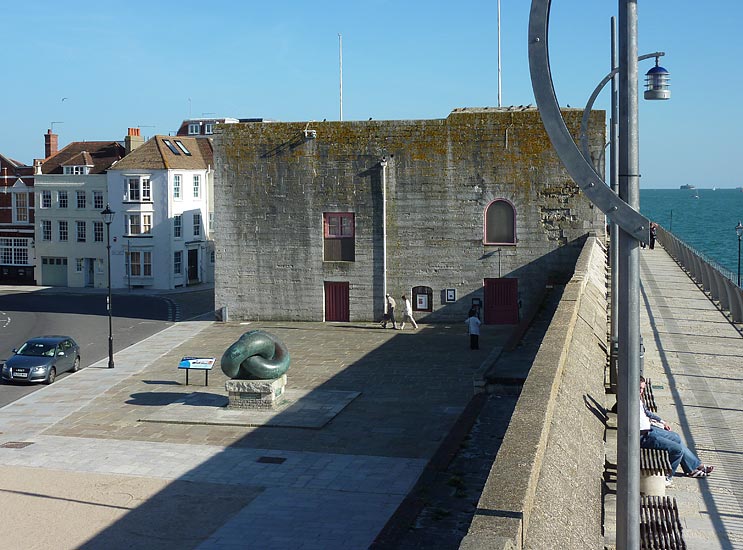 |
||||
| Click on photos to enlarge | ||||
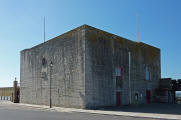

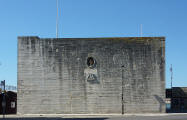 |
||||
| The Square Tower is part of the defensive
works around Old Portsmouth, in this case the stretch running along the
seashore at the
entrance to Portsmouth harbour. The tower dates from 1494 in the reign of Henry
VII. Refaced in stone in 1827. East and north face seen here. Used as residence of the military Governor of Portsmouth in the 1500s. Transformed into a powder magazine in 1580s, when it was reduced in height. Royal Navy meat store c.1779-1850. Plan of Old Portsmouth defences (external site) - Square Tower is no.9 In a recess on the east wall, a bust of Charles I, 1635 by Le Sueur. The inscription below it was longer, but the rest of it was obliterated with the refacing in 1827. Still visible: "After his travels through all France into Spain and having passed very many dangers both by sea and land he arrived here on the 5th day of October 1623" and now obliterated: "there was the greatest applause of joy for his safety throughout the Kingdom that was ever known or heard of." (from Portsmouth memorials website). Charles' journey took place before he became king and was connected with pursuit of a suitable royal match in the European power struggle (he failed - more here). The bust is now a firbreglass replica, the stone bust being in the City Museum. |
||||
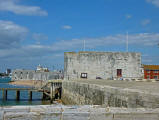
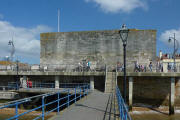
 |
||||
| South face and west face. Last picture: A wooden semaphore tower was placed on top from 1823 to 1848. Made redundant by electric telegraph. (Picture on display board outside the tower by Portsmouth City Council). | ||||
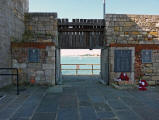 |
||||


 |
||||
| Memorials beside the Square Tower: 1. Sir Walter Raleigh's second colony sent to Roanoke Island in 1587 to build the first English village in America. 2. The first fleet to settle Australia. 3. Seamen who fell in the Falkland Islands war in 1982. | ||||
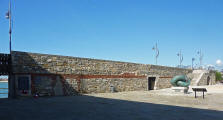
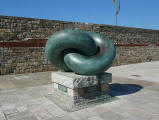 |
||||
| The town's defensive wall
to the north of the Square Tower. It dates from the late 1500s, although
the upper parts are reconstructed. The Old Sally Port towards the right was probably built in
the late 1700s. On the right, an abutment where stood King James' Gate,
taking one
out of the town to the harbour. The gate was moved in the 1870s to
Burnaby Road. In front of the Old Sally Port is a memorial sculpture to the sailing of the First Fleet in 1787 conveying settlers to Australia. The sculpture is by John Robinson and rests on a block of granite from New South Wales. Unveiled by the Queen in 1980. The memorial has a twin in Sydney Cove, Australia. More details on the sculptor's website. |
||||
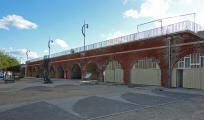

 |
||||
| Further north, beyond the site of King
James' Gate mentioned above, the Eighteen Gun Battery
stretches towards the Round Tower. The first picture shows the street
side, the next two the shore side, looking south and north from the
Common Sally Port through the wall (see below). At the north end is the
Flanking Battery at right angles, behind which stands the Round Tower. The Eighteen Gun Battery was originally built in the late 17th century, when it had gunports, now blocked but still visible. The battery was reconstructed in 1847-50, when the shallow casemates behind the gunports were greatly deepened inwards in brick, as shown in the first picture. On the Flanking Battery a second tier of three gunports was added. Entry in British Listed Buildings |
||||
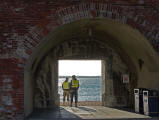
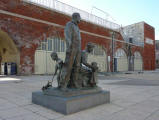 |
||||
| The Common Sally Port was created in one of the gunports in the Eighteen Gun Battery in the late 18th century, allowing access to the foreshore. In front of it is now a statue of a family about to emigrate to America. A plaque on the base reads "A permanent legacy to the commitment of the Europeans who courageously left their native lands to create a new home in America. Presented to the City of Portsmouth on 27th August 2001 by members of The Pioneer Heritage Foundation." (More about the monument) | ||||
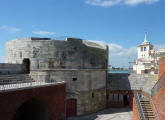
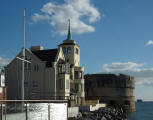 |
||||
| The Round Tower is
cylindrical, of three storeys separated by string courses. It was first
built by Henry V in 1418, but was subsequently rebuilt, possibly on the
original footings, about 1538-40 in the reign of Henry VIII. The ground
storey probably dates from that time. The upper two stories may date
from the the later 1600s when the defences of the town underwent a major
reconstruction, although there was also more reconstruction in
Napoleonic times. The second picture shows the view from the north with Tower House in front. This was occupied by the maritime artist William L. Wyllie from 1906 until his death in 1931. |
||||
| Map of Portsmouth | ||||
| Google Map for Square Tower | ||||
| More Portsmouth Buildings in Astoft | ||||